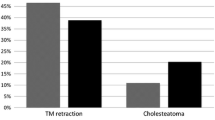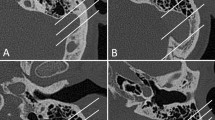Abstract
The objective of this study is to analyze the possible variations in size and shape of the AER in the ear affected by acquired cholesteatoma versus the healthy ear in the same patient. A total of 22 patients affected by acquired cholesteatoma were included in our study. A CT morphological evaluation of both ears (pathologic and non-pathologic) was made. Measures of the AER were done, on axial plane, parallel to incudomalleal axis for the deepest anterior-to-posterior (AP) diameter and perpendicular to this line for the maximum transverse (T) diameter, selecting the most inferior cut that showed the Cog in its entirety. A third superior–inferior (SI) measure was done, on coronal plane from the tegmen tympani to the cochleariform process. Comparisons between the mean of AP, T and SI in affected ears versus non-affected have been carried out using a paired t test. The AER measurement was considerably smaller in affected ears than in the non-affected ones. Mean AP ± DS was 5.1 (1.46) versus 3.1 (0.90), P values <0.0001. Mean T ± DS was 4.1 (0.74) versus 3.2 (0.74), P values <0.0014. Mean SI ± DS was 4.0 (1.01) versus 2.0 (0.82), P values <0.0001. In conclusion, based on our results, the AER in an affected ear seems smaller than in a non-affected one. Whether a hypovolumetric AER could be a congenital morphological condition predisposing cholesteatoma despite adequate aeration of the epitympanic compartment, on the contrary the presence of membranous and/or ligamentous folds could exclude the AER from the posterior epitympanic space and from the protympanum, predisposing it for attical dysventilation, should be clarified in further studies.





Similar content being viewed by others
References
Horn KL, Brackman DE, Luxord WM et al (1986) The supratubal recess in cholesteatoma surgery. Ann Otol Rhinol Laryngol 95:12–15
Proctor B (1964) The development of middle ear spaces and their surgical significance. J Laryngol Otol 78:632–648
Palva T, Ramsey H, Bohling T (1997) Tensor fold and anterior epitympanum. Am J Otol 18:307–316
Hammar JA (1902) Studien uber die Entwicklung des Vorder-darms und einiger angrenzender Organe. Arch Mikroskop Anat 59:471–628
Palva T, Johnson LG (1995) Epitympanic compartment surgical consideration: reevaluation. Am J Otol 16:505–513
Palva T, Ramsey H (1996) Incudal folds and epitympanic aeration. Am J Otol 17:700–708
Palva T, Ramsey H, Bohlurg J (1998) Lateral and anterior view to tensor fold and supratubal recess. Am J Otol 19:405–414
Hoshino T (1988) Surgical anatomy of the anterior epitympanic space. Arch Otolaryngol Head Neck Surg 114:1143–1145
Chu FWK, Jackler RK (1988) Anterior epitympanic cholesteatoma with facial paralysis: a characteristic growth pattern. Laryngoscope 98:274–279
Collins ME, Coker NJ, Igarashi M (1991) Inflammatory disease of the anterior epitympanum. Am J Otol 12:11–15
Mansour S, Nicolas K, Naim A et al (2005) Inflammatory chronic otitis media and the anterior epitympanic recess. J Otolaryngol 34:149–158
Valvassori GE, Buckingham RA (1995) Serial CT section of temporal bones anatomy. In: Valvassori GE, Mafee MF, Carter BL (eds) Imaging of the head and neck. Thieme, New York, pp 4–30
Swarts JD, Harnsberger HR (1994) The middle ear and mastoid. In: Swartz JD, Harnsberger HR (eds) Imaging of the temporal bone. Thieme, New York, pp 48–62
Petrus LV, Lo WWM (1997) The anterior epitympanic recess: CT anatomy and pathology. Am J Neuroradiol 18:1109–1114
Bezold F (1891) Uber das Cholesteatom des Mittelhors. Z Othrenheilkd 21:252–263
Young N, Chole R (2002) Retraction pocket cholesteatoma. Opin Otolaryngol Head Neck Surg 10:355–359
Palva T, Johnsson L-G, Ramsey H (2000) Attic aeration in temporal bones from children with recurring otitis media. Tympanostomy tubes did not cure disease in Prussak’s space. Am J Otol 21:485–493
Sade J, Fuchs C, Luntz M (1997) Shrapnell membrane and mastoid pneumatization. Arch Otolaryngol Head Neck Surg 123:584–586
Sade J (2001) Hyperectasis: the hyperinflated tympanic membrane: the middle ear as an actively controlled system. Otol Neurotol 22:133–139
Honda Y, Umezawa Y (1983) Pathogenesis of cholesteatoma. Oto Rhino Laryngol Tokyo 26:15–26
Morimitzu T, Nagai T, Nagai M et al (1989) Pathogenesis of cholesteatoma based on clinical results of anterior tympanostomy. Auris Nasus Larynx (Tokyo) 16(Suppl 1):9–14
Palva T, Northrop C, Ramsey H (2001) Aeration and drainage pathways of Prussak’s space. Int J Pediatr Otorhinolaryngol 57:55–65
Palva T, Ramsey H (2007) Aeration of Prussak’s space is independent of the supradiaphragmatic epitympanic compartment. Otol Neurotol 28:264–268
Chatellier HP, Lemoine J (1946) Le diaphragme interattico-tympanique du nouveau-né. Ann Oto Laryngol Chir Cervico-fac 13:534–566
Miyanaga S, Morimitsu T (1997) Prussak’s space: chronological development and routes of aeration. Auris Nasus Larynx 24:255–264
Yamasoba T, Kikuchi S (1993) Is an isthmus block a prerequisite for the development of an attic retraction cholesteatoma? Eur Arch Otorhinolaryngol 250:300–303
Kobayashi T, Toshima M, Yaginuma Y et al (1994) Pathogenesis of attic retraction pocket and cholesteatoma as studied by computer tomography. Am J Otol 5:658–662
Marchioni D, Mattioli F, Alicandri-Ciufelli M, Presutti L (2008) Endoscopic approach to tensor fold in patients with attic cholesteatoma. Acta Otolaryngol 19:1–9
Conflict of interest statement
The authors declare that they have no conflict of interest.
Author information
Authors and Affiliations
Corresponding author
Rights and permissions
About this article
Cite this article
Marchioni, D., Mattioli, F., Cobelli, M. et al. CT morphological evaluation of anterior epitympanic recess in patients with attic cholesteatoma. Eur Arch Otorhinolaryngol 266, 1183–1189 (2009). https://doi.org/10.1007/s00405-008-0871-x
Received:
Accepted:
Published:
Issue Date:
DOI: https://doi.org/10.1007/s00405-008-0871-x




